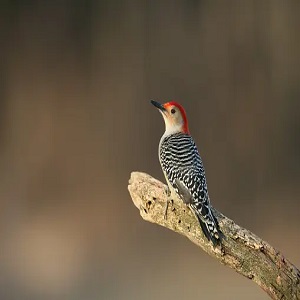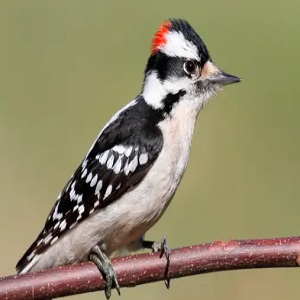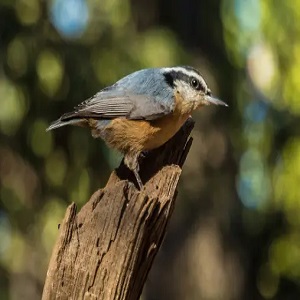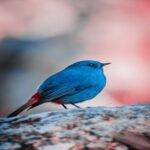Woodpeckers of North Carolina (NC) are a diverse and fascinating group of birds that play important roles in the state’s ecosystems. North Carolina is home to eight distinct species of woodpeckers, each with its own unique characteristics, habits, and habitats. In this introduction, we will explore these woodpecker species, provide interesting facts about them, and discuss their preferred habitats.
The 8 species of the woodpeckers in NC are:
1. Downy Woodpecker
2. Hairy Woodpecker
3. Red-bellied Woodpecker
4. Red-headed Woodpecker
5. Pileated Woodpecker
6. Northern Flicker
7. Red-cockaded Woodpecker
8. Yellow-bellied Sapsucker
8 Types of Woodpeckers in NC
Let’s see the list of 8 species of woodpeckers in NC, and learn where they live, what they eat, how they breed and their appearance.
1. Red-headed Woodpeckers (Melanerpes erythrocephalus):
The Red-headed Woodpecker (Melanerpes erythrocephalus) is a striking bird species found in North Carolina and across North America. Its most distinctive feature is its vibrant, all-red head, contrasted by a pristine white body and glossy black wings. With a length of about 7-9 inches, these medium-sized woodpeckers known for their remarkable aerial acrobatics, including a unique “rolling” flight pattern.

These woodpeckers have a varied diet, consisting of insects, fruits, nuts, and occasionally small vertebrates. They are skilled at catching insects in mid-air and are often seen swooping down to catch prey on the wing. Red-headed Woodpeckers known for their preference for dead trees. Which they use both for nesting and as a pantry for storing food items, such as insects and acorns.
Unfortunately, the Red-headed Woodpecker population has declined in recent years due to habitat loss and competition for nesting sites. Conservation efforts are underway to protect their preferred habitats, making it vital to appreciate and safeguard these striking birds for future generations to enjoy.
2. Pileated Woodpeckers (Dryocopus Pileatus):
The Pileated Woodpecker is one of North America’s most impressive and iconic woodpecker species, and it is notably the largest among them. With its striking appearance, this bird commands attention. It characterizes a striking red crest on its head, a black body, and striking white markings. The Pileated Woodpecker’s distinctive call and resonant drumming sound through the forests it inhabits, making it easily identifiable.

These woodpeckers are renowned for their foraging skills, using their chisel-like bills to excavate large rectangular holes in search of carpenter ants and other insects. Their preferred habitats include mature forests, particularly in bottomlands and swampy areas.
Pileated Woodpeckers play a crucial role in forest ecosystems by helping control insect populations and creating nesting cavities that benefit various other bird species. Their continued presence in North Carolina’s woodlands is a testament to the state’s commitment to conserving its natural heritage and biodiversity.
3. Downy Woodpecker (Picoides Pubescens):
The Downy Woodpecker is a charming and petite member of the woodpecker family, found throughout North America, including North Carolina.

Measuring around 5-6 inches in length, the Downy Woodpecker features striking black wings adorned with white spots and a white underside. Males can be identified by a small red patch on the back of their heads, while females lack this feature. Their small size and striking markings make them easily recognizable, even to novice birdwatchers.
These adaptable birds known for their agility in moving along tree branches and trunks, using their tiny, pointed bills to search for insects, particularly beetles, caterpillars, and ants. They also visit bird feeders, where they enjoy suet and seeds.
Downy Woodpeckers found in a variety of habitats, including woodlands, orchards, parks, and suburban gardens. Their ability to thrive in different environments has made them a familiar sight to many bird enthusiasts.
Despite their diminutive size, Downy Woodpeckers play a vital role in ecosystems by helping control insect populations, making them valuable contributors to the balance of local ecosystems in North Carolina and beyond. Their delightful presence and adaptability make them a favorite among birdwatchers and a symbol of the state’s diverse avian life.
4. Hairy Woodpecker (Picoides Villosus):
The Hairy Woodpecker is a charismatic and widely recognized woodpecker species found throughout North America, including in North Carolina. This bird, slightly larger than its close relative, the Downy Woodpecker, boasts distinctive features that make it a favorite among birdwatchers and nature enthusiasts.
Hairy Woodpeckers characterize their striking black and white plumage, similar to the Downy Woodpecker, but with a larger size. They have a striking white underside and a white stripe down the center of their black wings, which contrasts beautifully with their pure white belly. Perhaps one of their most distinguishing features is the long, sturdy bill, which they use to drum on trees and search for insects beneath the bark.

These woodpeckers are highly adaptable and can be found in a variety of habitats, including forests, woodlots, and even suburban areas with ample tree cover. They are skilled foragers, primarily feeding on insects, larvae, and spiders found under tree bark. They also visit bird feeders for suet and seeds, making them a common sight in backyards across North Carolina.
Hairy Woodpeckers known for their persistent drumming and loud calls, especially during the breeding season. They excavate nest cavities in tree trunks for nesting, contributing to the creation of essential nesting sites for other cavity-nesting bird species.
In North Carolina, the Hairy Woodpecker is not only a symbol of resilience and adaptability but also a key player in maintaining the ecological balance of the state’s woodlands. Observing these elegant birds in their natural habitats is a rewarding experience for bird enthusiasts and a testament to the beauty of North Carolina’s avian diversity.
Falcons VS Hawks: 10 Important Facts What’s The Difference Between A Hawk And A Falcon?
5. Northern Flicker (Colaptes Auratus):
The Northern Flicker is a distinctive and captivating woodpecker species found throughout North America, including parts of North Carolina. Recognizable by its unique appearance and behavior, the Northern Flicker stands out among woodpeckers.
These medium-sized woodpeckers typically measure around 12 inches in length. Their plumage characterize spotted brown upper body with a prominent white rump, and their wings display a striking black crescent. When in flight, the Northern Flicker’s wings produce a noticeable “flickering” effect, which is how they earned their name.

One of the Northern Flicker’s most intriguing habits is its preference for foraging on the ground. They have a keen appetite for ants and beetles, using their long, slightly curved bill to probe into the soil in search of these insects. This behavior distinguishes them from many other woodpecker species.
Northern Flickers are adaptable birds, inhabiting a range of environments, including woodlands, grasslands, and open areas with scattered trees. They also nest in cavities in trees or wooden structures, adding to their versatility.
These woodpeckers are not only fascinating to observe but also play a crucial role in controlling insect populations, making them an important component of North Carolina’s diverse avian community. Their unique characteristics and behaviors make the Northern Flicker a cherished and valued resident of the state’s natural landscape.
6. Red-bellied Woodpecker (Melanerpes Carolinus):
The Red-bellied Woodpecker is a charismatic bird species native to eastern North America, known for its distinctive appearance and behavior. Despite its name, the “red belly” of this woodpecker is rather faint and often overshadowed by its striking features.
Red-bellied woodpeckers display a striking combination of black and white plumage on their wings, back, and head. However, the most eye-catching feature is their bright red cap, which extends from the forehead to the nape of their neck. This vibrant crown distinguishes them from other woodpecker species and is more prominent in males.

These woodpeckers are adaptable and have successfully adapted to suburban and urban environments, making them a common sight in wooded neighborhoods and parks. They are highly skilled at clinging to tree trunks and branches, using their strong bills to probe for insects, their primary food source, as well as nuts, seeds, and berries. They often store food in crevices or under tree bark for later consumption.
Red-bellied woodpeckers known for their distinctive calls and drumming sounds. They typically nest in tree cavities, often reusing old woodpecker holes or excavating new ones. Their nesting sites are highly sought after by other bird species as well.
7. Yellow-bellied Sapsucker (Sphyrapicus Varius):
The Yellow-bellied Sapsucker is a migratory woodpecker species known for its unique feeding habits and striking plumage. These birds are native to North America and can be found in various regions, including parts of North Carolina.
One of the most distinctive characteristics of the Yellow-bellied Sapsucker is its habit of drilling small holes in tree bark to feed on sap. They refer to as “sapsuckers” because of this behavior. These birds are equipped with specialized tongues with bristle-like tips that help them lap up the flowing sap and catch any insects attracted to it.

In terms of appearance, Yellow-bellied Sapsuckers exhibit sexual dimorphism. Males typically have a bright red throat and crown, while females have a white throat. Both genders have striking black and white markings on their wings and bodies, making them easily recognizable.
During migration, Yellow-bellied Sapsuckers can be found in various habitats, including deciduous and mixed forests. They often travel in search of suitable trees to tap for sap and insects. These birds play a vital role in order to provide a food source for other wildlife.
Overall, the Yellow-bellied Sapsucker is a fascinating woodpecker species known for its specialized feeding habits and colorful plumage, making it a welcomed sight for bird enthusiasts in North Carolina and beyond.
South Dakota State Bird: Ring-Necked Pheasant – Fun Facts & More! [2023]
8. Northern Red-breasted Sapsucker (Sphyrapicus Ruber):
The Northern Red-breasted Sapsucker (Sphyrapicus ruber) is a distinctive woodpecker species primarily found in western North America, including parts of North Carolina during migration. As a member of the sapsucker family, it shares the unique behavior of drilling small holes in tree bark to feed on sap, although it is not as common in North Carolina as its yellow-bellied counterpart.

This woodpecker known for its striking appearance, with a bright red head and throat, making it easy to identify. Its plumage features a combination of black and white markings, and it has a pale yellow wash on its belly. These vibrant colors make the Northern Red-breasted Sapsucker a standout in wooded mountainous regions.
In terms of habitat, this species prefers coniferous and mixed forests, particularly in mountainous areas, where it can find suitable trees for sap-feeding and nesting. Like other sapsuckers, they play an essential role in their ecosystems by creating sap wells that attract insects and serve as a food source for other wildlife.
While the Northern Red-breasted Sapsucker may not be a year-round resident of North Carolina, its seasonal visits add to the state’s avian diversity, and its striking appearance makes it a sought-after sighting for birdwatchers lucky enough to spot one during migration.
Where To Find Woodpeckers in NC
North Carolina offers a diverse range of habitats that are home to several woodpecker species. Whether you’re an avid birder or simply interested in spotting these fascinating birds, here are some places where you can find woodpeckers in North Carolina:
- Great Smoky Mountains National Park: This iconic national park in western North Carolina is a prime location to spot woodpeckers. Look for species like the Pileated Woodpecker, Northern Flicker, and Red-bellied Woodpecker in the lush forests.
- Uwharrie National Forest: Located in central North Carolina, this forest is home to various woodpecker species. Explore the hardwood and pine forests for the chance to see Downy Woodpeckers, Hairy Woodpeckers, and Red-headed Woodpeckers.
- Croatan National Forest: Along the coast of North Carolina, the Croatan National Forest offers excellent birdwatching opportunities. Keep an eye out for Red-headed Woodpeckers, Red-bellied Woodpeckers, and even the occasional Yellow-bellied Sapsucker.
- Jordan Lake State Recreation Area: This area, situated near Raleigh and Durham, provides a mix of woodlands and waterfront habitats. Here, you may encounter Northern Flickers, Downy Woodpeckers, and Red-headed Woodpeckers.
- Pisgah National Forest: In the western part of the state, Pisgah National Forest’s diverse ecosystems are home to numerous woodpecker species. Keep an ear out for the distinctive call of the Pileated Woodpecker as you explore the forest.
- Umstead State Park: Located near the Research Triangle Park, Umstead State Park offers a convenient place to spot woodpeckers for those in the Raleigh-Durham area. Look for Downy Woodpeckers, Hairy Woodpeckers, and Red-bellied Woodpeckers in this urban oasis.
- Neuse River Greenway Trail: In the capital city of Raleigh, this greenway trail along the Neuse River is an accessible spot for birdwatching. Keep an eye on tree trunks for Downy Woodpeckers and Red-bellied Woodpeckers.
Conclusion:
The woodpeckers of North Carolina represent a diverse and captivating group of bird species that contribute significantly to the state’s ecosystems. With eight distinct species inhabiting various regions of North Carolina. These woodpeckers play crucial roles in maintaining the health of forests and woodlands. From the iconic Red-headed Woodpecker to the majestic Pileated Woodpecker and the unique Yellow-bellied Sapsucker. Each species has its own distinctive characteristics, habits, and preferred habitats.
These woodpeckers known for their vibrant plumage and striking appearances but also for their essential ecological roles. They help control insect populations by foraging for insects beneath tree bark, thus benefiting the overall health of forests. Moreover, they create nesting cavities that serve as homes for other bird species.
Studying and conserving the woodpecker populations in North Carolina is essential for preserving the state’s rich biodiversity. Protecting their habitats, including mature forests, woodlots, and urban green spaces, is crucial to ensuring their continued presence in the region.
FAQs:
What types of woodpeckers can be found in North Carolina?
North Carolina is home to several woodpecker species, including the Downy Woodpecker, Hairy Woodpecker, Red-bellied Woodpecker, Northern Flicker, and the elusive Pileated Woodpecker, among others. Each species has unique characteristics and habitats within the state.
Where is the best place to spot woodpeckers in North Carolina?
Woodpeckers can be found throughout North Carolina’s diverse ecosystems. Some popular spots for birdwatching include the Great Smoky Mountains National Park, Umstead State Park, and Croatan National Forest. Look for wooded areas with plenty of mature trees and deadwood, as these are often prime habitats for woodpeckers.
What is the significance of woodpeckers in North Carolina’s ecosystem?
Woodpeckers play a crucial role in the ecosystem by helping control insect populations, particularly those that infest trees. Woodpeckers are important indicators of forest health and biodiversity.
Are woodpeckers in North Carolina protected by any conservation measures?
Yes, many woodpecker species in North Carolina are protected by federal and state conservation laws. The Endangered Species Act, for example, offers protection to the critically endangered Red-cockaded Woodpecker. Conservation efforts aim to preserve and restore woodpecker habitats in the state.
How can I attract woodpeckers to my backyard in North Carolina?
To attract woodpeckers to your backyard, consider putting up bird feeders with suet or peanuts, as many woodpecker species are attracted to these foods. Planting native trees and shrubs that produce berries and insects can also provide natural food sources. Providing dead trees or dead branches can create nesting and foraging opportunities for woodpeckers while adding a water source like a bird bath can further entice them.


![Best Deer Proof Bird Feeder For Your Garden [2023]](https://vetpomedix.com/wp-content/uploads/2023/09/Gray-Bunny-Wild-Bird-Feeder-150x150.jpg)